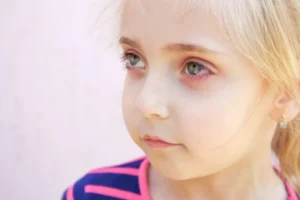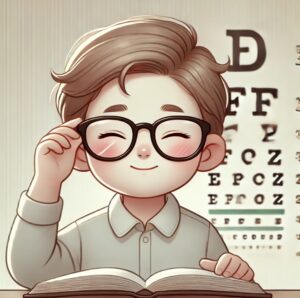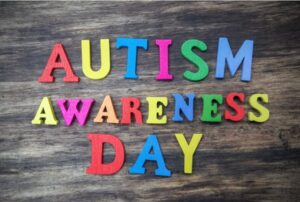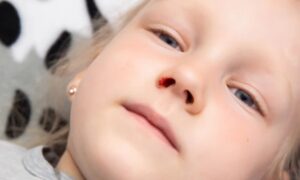Case Study
Five-year-old Lucas had recently been squinting while reading at preschool and sometimes tilted his head to look at things. His teacher noticed that his eyes seemed "misaligned" and advised his parents to get an eye checkup. After seeing an eye doctor, Lucas was diagnosed with strabismus and needed early intervention and correction.
Children like Lucas are not uncommon. Strabismus is a common eye condition in children, and if not treated in time, it can affect vision development and may even lead to amblyopia (lazy eye). So, how should parents correct strabismus in children? How can they help their child restore normal vision? This article will explain the methods for correcting strabismus and guide parents in making the right choices.
What is Strabismus in Children?
Strabismus (also known as "crossed eyes") is when the two eyes cannot focus on the same point at the same time. One eye focuses normally, while the other eye deviates. The common types of strabismus include:
- Esotropia: Also known as "crossed eyes," where the eyes turn inward.
- Exotropia: Where the eyes turn outward.
- Hypertropia: Where the eyes turn upward.
- Hypotropia: Where the eyes turn downward.
Risks of Strabismus: If not corrected, strabismus can affect the development of depth perception and lead to amblyopia, causing permanent vision loss.
How to Correct Strabismus in Children?
The treatment for strabismus in children depends on the type of strabismus, its severity, and the child's age. Here are the common methods of correction:
Wearing Corrective Glasses
- When it’s used:
- For strabismus caused by refractive errors (like farsightedness causing esotropia).
- For mild cases of strabismus to help both eyes focus properly.
- How it works:
- The doctor will prescribe corrective glasses based on the child's eye test results, helping the eyes align better. In some mild cases of esotropia, wearing glasses long-term may improve the condition.
Vision Therapy (Visual Function Training)
- When it’s used:
- For accommodative strabismus or some non-accommodative types.
- For children with poor eye muscle coordination.
- How it works:
- Occlusion therapy: Cover the dominant eye to encourage the weaker eye to work, preventing amblyopia.
- Fusion training: Using special cards or software to help both eyes work together and improve depth perception.
- Eye movement training: Following a target with the eyes to strengthen eye muscle control.
- This training must be done under a doctor's supervision, and parents can help their child practice at home.
Wearing an Eye Patch (Occlusion Therapy)
- When it’s used:
- For children with strabismus and amblyopia.
- For children who need to strengthen vision in one eye.
- How it works:
- The doctor may suggest covering the stronger eye with an eye patch, forcing the weaker eye to work and improve visual function. The amount of time the patch is worn (usually 2-6 hours per day) will be prescribed by the doctor.
Botox Injections
- When it’s used:
- For some cases of exotropia or neurogenic strabismus.
- For children who prefer not to undergo surgery but need short-term correction.
- How it works:
- The doctor will inject botulinum toxin into the eye muscles under anesthesia to relax the overactive muscles and help align the eyes. This method is temporary, and some children may need repeat injections or additional treatments.
Strabismus Surgery
- When it’s used:
- For severe strabismus or non-accommodative types.
- When other correction methods are ineffective.
- How it works:
- The surgeon adjusts the length or position of the eye muscles to align the eyes properly. The surgery is usually done under general anesthesia, has low risks, and has a quick recovery time. Post-surgery, the child will need to continue vision therapy for optimal results.
What Should Parents Pay Attention to During Treatment?
- Early intervention: The critical period for vision development is before age 6, and earlier treatment yields better results.
- Regular eye checkups: Even if there is no obvious strabismus, a comprehensive eye check at around age 3 is recommended.
- Encourage consistency in therapy: Especially with visual training and occlusion therapy, parents need to be patient and supervise their child to ensure they stick to the treatment plan.
- Limit screen time: Excessive use of electronic devices like smartphones and tablets can lead to eye strain and affect the effectiveness of treatment.
Can Strabismus Be Fully Cured?
Most cases of strabismus in children, when identified early and treated actively, can be corrected well. Some mild cases may even return to normal vision. However, if treatment is delayed, it can affect vision development and lead to permanent amblyopia. Therefore, parents should take their child’s vision health seriously and implement appropriate corrective measures as soon as possible.
Key Takeaway
Every child’s situation is unique, and the method of correcting strabismus will vary. Parents need to work closely with an eye specialist to choose the most suitable treatment for their child. Whether it’s wearing glasses, undergoing visual training, or considering surgery, the key is early detection and active intervention to help the child maintain healthy eyes.













